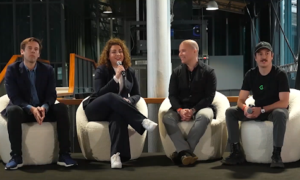In the ever-evolving world of e-commerce, staying ahead of the curve is essential for success. As businesses grapple with increasing demands for high-quality content, many are turning to artificial intelligence (AI) to give them a competitive edge. The potential of AI to streamline content creation and enhance productivity has caught the attention of industry well-known names, and TVape, a well-known name in the vaporizer market, stands out as a prime example of this transformative trend.
My search for companies eager to share their AI experiences led me to platforms like SourceBottle, HARO, and Connectively. It was through these channels that TVape reached out, offering a window into their innovative use of AI. Their willingness to share their journey provided valuable insights into how AI is reshaping the content landscape, from increasing efficiency to improving content quality.
Our conversation with TVape revealed a story of technological integration and operational evolution. As the company faced the challenge of scaling its content output while maintaining high standards, it turned to AI tools to meet this demand. What emerged was a compelling narrative of how AI not only enhanced their content creation process but also contributed to their overall business growth.
AI Revolution: How Automation is Shaping the Future of Content Creation
TVape’s adoption of AI has notably influenced their ability to produce content efficiently while maintaining quality. With the help of tools like ChatGPT, DeepL, and Copilot, the company has managed to increase their content production significantly. For example, AI integration has allowed TVape to launch twice as many products across various categories, including dry herb vaporizers, 510 thread batteries, and e-rigs. Additionally, they have expanded their volume of product reviews, publishing four times as many reviews on popular vaporizers.
This increase in content output reflects the practical advantages of using AI to support content creation. Despite these advancements, TVape continues to rely on human oversight to ensure the accuracy and authenticity of its content. How do they achieve this balance? Let’s explore further:
1. Streamlining Multilingual Content Creation
A major challenge for TVape has been producing high-quality content in multiple languages. Their websites cater to diverse markets, including German, French, and Spanish-speaking audiences. To address this, they have effectively harnessed AI technology to streamline content creation. This approach mirrors broader industry trends where AI is used to boost productivity in global business settings. As highlighted by Forbes, AI translation tools are instrumental in improving efficiency and accuracy in multilingual content production.
So, how does this process work? Well, TVape employs AI to draft initial content, which junior writers then refine. This process not only accelerates content creation but also enhances translation precision. AI models like ChatGPT facilitate quick and accurate translations, although the final drafts are meticulously reviewed by language experts to ensure they align with the company’s high standards.
The integration of AI into TVape’s content process reflects the growing trend of using AI to enhance productivity across industries. This approach aligns with broader advancements in AI writing technology, which are designed to streamline and improve content creation. For TVape, this means reduced turnaround times for multilingual content and a consistent brand voice across various regions, all while keeping the content engaging and relevant for a global audience. As discussed in Microsoft’s overview of AI writing, AI tools are increasingly being utilized to boost efficiency and effectiveness in writing tasks, further supporting TVape’s strategy.
2. Converting Audio Insights into Written Material
TVape has also optimized its content creation process by using AI to convert audio insights into written content. When new products arrive, their product experts record their observations and reviews using tools like Windows Voice Recorder and OBS Studio. These recordings are then transcribed by AI-powered tools, with junior writers refining the text into a coherent draft. The final version is subjected to a thorough review by subject matter experts to ensure it accurately reflects the experts’ insights.
This method highlights AI’s role in efficiently transforming spoken content into well-crafted written material. By automating transcription and initial drafting, this company has streamlined their content creation process, allowing for faster turnaround times and more detailed product reviews. However, challenges remain in ensuring that AI-generated content maintains the same level of creativity and nuance as human-written material.
3. Enhancing Workflow and Collaboration
The integration of AI has brought transformative improvements to TVape’s workflow and team collaboration. Previously, the content creation process relied heavily on manual effort, making it time-consuming and cumbersome. By incorporating AI tools like ChatGPT and Copilot, TVape has streamlined various aspects of content production, from drafting to editing, significantly boosting efficiency.
AI’s ability to automate routine tasks—such as drafting initial content and conducting research—has accelerated the workflow, allowing junior team members to complete tasks faster and enabling senior experts to focus on strategic and creative roles. This shift has created a more dynamic and collaborative work environment. As highlighted by Harvard Business Review, such advancements in AI are pivotal for optimizing workflows and enhancing team efficiency, demonstrating how these technologies can revolutionize productivity and transform traditional processes.
4. Optimizing Existing Content with AI
TVape is also utilizing AI to refine and optimize its existing content. SEO tools with AI capabilities, such as Semrush and Clearscope, play a crucial role in enhancing content performance on search engines. These tools analyze content for SEO effectiveness and provide recommendations for improvement.
Experts conduct initial research and guide junior writers in implementing AI-driven SEO strategies. This process ensures that TVape’s content remains competitive and visible in search engine results, driving more traffic to their website. By continuously optimizing existing content, TVape maintains its relevance and effectiveness in a rapidly changing digital landscape.
The Growing Role of AI in Content Creation
As the demand for high-quality content continues to rise, traditional methods may struggle to keep up. AI tools like ChatGPT and Copilot offer scalable solutions to content creation challenges, allowing businesses to produce engaging content efficiently. The ability of AI to generate large volumes of content quickly and accurately is crucial for businesses aiming to stay competitive in the digital age. By embracing AI, companies can maintain dynamic and engaging digital platforms without overstretching their resources.
TVape’s innovative use of AI exemplifies how technology can drive content creation forward, setting a precedent for others in the e-commerce space and reflecting broader trends in AI’s impact on business, employment, and digital transformation.
Conclusion
Integrating AI into content creation is reshaping the e-commerce landscape, offering unprecedented opportunities for efficiency and quality. TVape’s innovative use of AI tools like ChatGPT, DeepL, and Copilot showcases the transformative potential of these technologies. By leveraging these tools, TVape has streamlined multilingual content creation and optimized existing material, enhancing the overall customer experience across its platforms. For instance, their USA site, Toronto Vaporizer, exemplifies how AI-driven strategies are employed to deliver high-quality, localized content effectively.
As businesses navigate the digital age, embracing AI can provide a competitive edge, enabling them to meet the growing demands for high-quality content while maintaining authenticity and relevance. TVape’s journey serves as a compelling example of how AI can drive content creation forward, setting a precedent for others to follow. As technology continues to evolve, the future of content creation promises even greater advancements and opportunities.



































